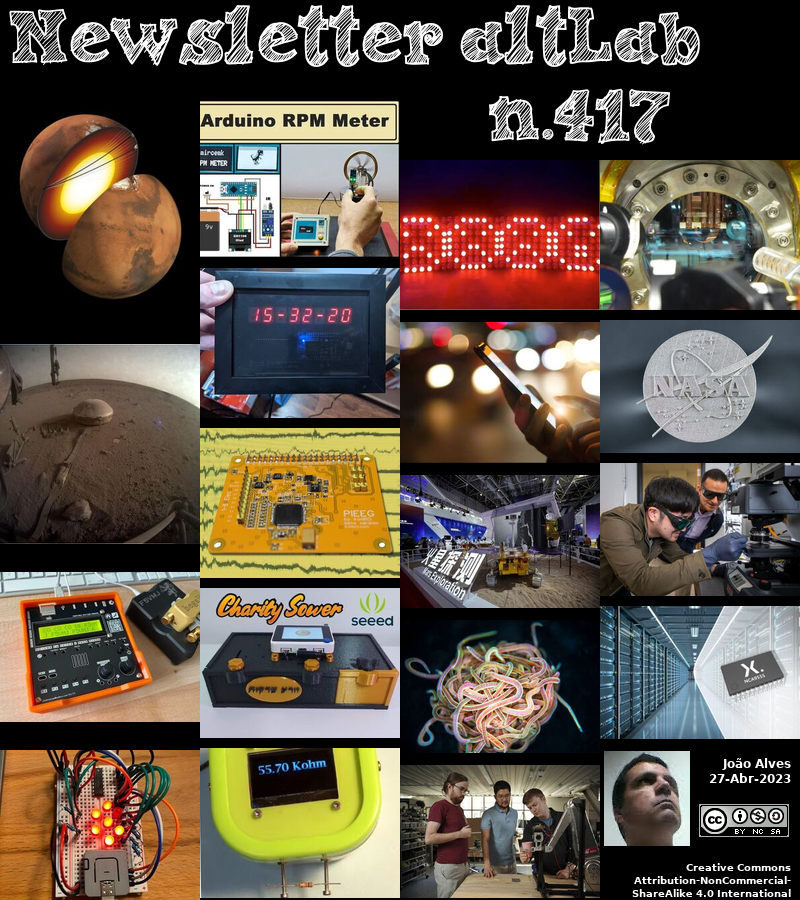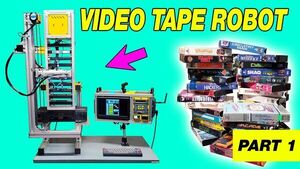2023-04-27 - Nº 417
Editorial
Esta é a Newsletter Nº 417 que se apresenta com o mesmo formato que as anteriores. Se gostar da Newsletter partilhe-a!
Todas as Newsletters encontram-se indexadas no link.
Esta Newsletter tem os seguintes tópicos:
Faz hoje anos que nascia, em 1791, o artista e inventor americano Samuel Morse. Ele ficou famoso pelo desenvolvimento do Código Morse (1838) e pelo aperfeiçoamento independente de um telégrafo eléctrico (1832-35). Passou a primeira parte da sua vida como retratista e só se dedicou à ciência em 1832, quando já tinha passado o seu 40º aniversário. Estava a regressar à América depois de uma viagem pela Europa, quando conheceu Charles T. Jackson no barco, que o inspirou sobre os recém-descobertos electroímanes. A partir daí, Morse trabalhou para desenvolver aparelhos para comunicações eléctricas. Com o apoio do Congresso, construiu uma linha de 40 milhas entre Baltimore, Maryland e Washington D.C., que teve o seu primeiro ensaio em 23 de Maio de 1843. Ficou pronta para utilização pública em 1 de Abril de 1845.
Faz também hoje anos que nascia, em 1846, o inventor belgo-americano Charles Joseph Van Depoele. Ele foi pioneiro nos caminhos-de-ferro, na iluminação eléctrica e no trabalho mineiro, com mais de 100 patentes de invenções eléctricas. Emigrou para os Estados Unidos em 1869. Enquanto fazia experiências com motores eléctricos em Detroit (1874), estabeleceu a praticabilidade dos vagões ferroviários movidos a electricidade. Inventou um gerador eléctrico (1880) e exibiu um eléctrico em funcionamento na Exposição de Aparelhos Ferroviários de Chicago (1883). Concebeu sistemas de eléctricos para várias cidades. Em 1888, vendeu as suas patentes de caminhos-de-ferro eléctricos à Thomson-Houston Electric Company de Lynn, Massachusetts. As suas outras patentes incluem: lâmpada de arco (1870), máquina de extracção de carvão (1891), locomotiva eléctrica sem engrenagens (1894).
Faz igualmente hoje anos que nascia, em 1896, o químico norte-americano Wallace Carothers. Ele desenvolveu o nylon (1935), a primeira fibra de polímero sintético a ser fiada a partir de uma fusão. Produziu esta poliamida por condensação do ácido adípico e da hexametilenodiamina. Trabalhou para a empresa química duPont como chefe de investigação em química orgânica a partir de 1928. Através do seu estudo de moléculas de cadeia longa, actualmente designadas por polímeros, desenvolveu também a primeira borracha sintética bem sucedida, o neopreno (1931). A DuPont produziu o nylon comercialmente a partir de 1938 e lançou as bases da indústria de fibras sintéticas. O nylon revelou-se excelente nas suas propriedades como análogo sintético da seda.
Por fim, faz hoje anos que nascia, em 1942, o cosmonauta e médico russo Valeri Polyakov. Ele estabeleceu o recorde da mais longa estadia contínua no espaço, 438 dias (8 de Janeiro de 1994 - 22 de Março de 1995) a bordo da estação espacial russa Mir. Com uma estadia anterior de 241 dias na Mir (29 de Agosto de 1988 - 27 de Abril de 1989), também detinha o recorde de resistência espacial acumulada de 679 dias. Deixou o serviço espacial em 1 de Junho de 1995. A sua formação incluiu medicina astronáutica. Em 22 de Março de 1972, foi seleccionado como cosmonauta especialista em biomedicina para uma missão planeada à estação espacial e começou a treinar em Outubro de 1972. O recorde cumulativo de permanência no espaço foi posteriormente batido por Sergei Avdeyev em 13 de Agosto de 1999 (3 missões, total de 748 dias) e depois em 16 de Agosto de 2005 por Sergei Krikalev (6 missões, total de 803 dias).
Em 1880, a primeira patente americana para um aparelho auditivo eléctrico foi concedida a Francis D. Clarke e M.G. Foster, intitulada "Device for Aiding the Deaf to Hear" (Dispositivo para ajudar os surdos a ouvir) (n.º 226.902). O dispositivo utilizava a condução óssea, através da qual o som é transmitido pela vibração do osso do crânio. Só em 1901 é que foi produzido o primeiro aparelho auditivo disponível no mercado, o Acousticon, inventado por Miller Reese Hutchinson.
Em 1970, a síntese do elemento 105, através da fusão de núcleos de califórnio e azoto, foi comunicada na reunião da American Physical Society em Washington, D.C., por Albert Ghiorso do Lawrence Radiation Laboratory da Universidade da Califórnia em Berkeley. O elemento artificial tinha uma massa atómica de 260, meia-vida de cerca de 1,6 segundos e uma prova melhor do que uma tentativa russa de 1968, que a equipa americana considerava não provada. Foi proposto o nome hahnium, em homenagem ao falecido Otto Hahn. Eventualmente, a União Internacional para a Química Pura e Aplicada decidiu que se chamaria dúbio e reconheceu a anterior reivindicação de descoberta em 1968 por uma equipa liderada por Georgy Flerov no Instituto Conjunto Russo de Investigação Nuclear que bombardeou amerício com néon."
E nesta semana que passou foi lançada uma nova versão do kernel Linux com uma série de melhorias de hardware, desempenho e segurança. Como seria de esperar, o kernel 6.3 do Linux apresenta uma quantidade enorme código para suporte de CPUs e hardware gráfico da Intel e da AMD que ainda não foram lançados. Por muito excitantes (e necessários) que sejam, é um pouco difícil sentirmo-nos entusiasmados quando, poucas pessoas irão beneficiar imediatamente. Felizmente, há muitas alterações que têm um impacto mais directo na nossa utilização quotidiana. Uma mudança notável relacionada à AMD no Linux 6.2 é o suporte ao IBRS automático da AMD para mitigação de Spectre. Isto oferece um menor impacto no desempenho do que a execução especulativa retpoline que é frequentemente utilizada actualmente. No que diz respeito à arquitectura, novos drivers de gestão de energia para ARM e RISC-V são lançados no Linux 6.3. O último também recebe suporte para funções de string aceleradas (por meio da extensão de manipulação de bits Zbb) e o primeiro ganha suporte para instruções de extensão de matriz escalável 2. Nos sistemas de ficheiros, o sistema de ficheiros NFS (tanto do lado do cliente como do lado do servidor) suporta agora encriptação baseada em AES-SHA2; optimizações para o desempenho de E/S directa do EXT4; descompressão de baixa latência para o EROFS, e um controlador de sistema de ficheiros Brtfs mais rápido. O suporte de hardware traz uma interface de controlador Steam Deck nativa em HID, permite que o volante de corrida Logitech G923 Xbox edition funcione no Linux; melhora o comportamento dos controladores com fio 8BitDo Pro 2; e adiciona monitorização de sensores para uma série de motherboard Ryzen da ASUS. Além disso, mais de 150.000 linhas de código para suportar placas ARM (antigas e não utilizadas) foram removidas nesta actualização.
Na Newsletter desta semana apresentamos diversas noticias, artigos científicos, projetos de maker e alguns vídeos interessantes. São apresentadas as revistas HackSpace Magazine Nº 66 e a MagPI nº 129 de Maio.
 João Alves ([email protected])
João Alves ([email protected])
O conteúdo da Newsletter encontra-se sob a licença  Creative Commons Attribution-NonCommercial-ShareAlike 4.0 International License.
Creative Commons Attribution-NonCommercial-ShareAlike 4.0 International License.
Novidades da Semana

Linux Kernel 6.3 Released, This is What’s New
"A new version of the Linux kernel is out with an assortment of hardware, performance, and security improvements. Announcing the release of Linux 6.3 over on the Linux kernel mailing list (LKML) Linus Torvalds remarked “…here we are, right on schedule, with the 6.3 release out and ready for your enjoyment”. So what’s new? Let’s take a breezy whip (and I do mean breezy) through the new n’ notable. Linux 6.3: New Features As you’d expect Linux kernel 6.3 features a ton of enablement and support for upcoming and yet-to-be-released CPUs and graphics hardware from Intel and AMD. As exciting (and necessary) as these are they’re a bit hard to feel hype for when, y’know, few people will benefit right away." [...]
Outras Notícias
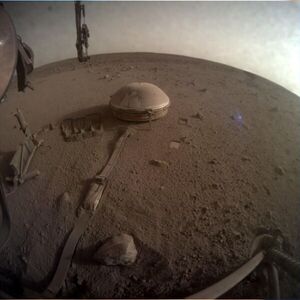
NASA InSight Study Provides Clearest Look Ever at Martian Core
"A pair of quakes in 2021 sent seismic waves deep into the Red Planet’s core, giving scientists the best data yet on its size and composition. While NASA retired its InSight Mars lander in December, the trove of data from its seismometer will be pored over for decades to come. By looking at seismic waves the instrument detected from a pair of temblors in 2021, scientists have been able to deduce that Mars’ liquid iron core is smaller and denser than previously thought. The findings, which mark the first direct observations ever made of another planet’s core, were detailed in a paper published April 24 in the Proceedings of the National Academies of Sciences. Occurring on Aug. 25 and Sept. 18, 2021, the two temblors were the first identified by the InSight team to have originated on the opposite side of the planet from the lander – so-called farside quakes. The distance proved crucial: The farther a quake happens from InSight, the deeper into the planet its seismic waves can travel before being detected." [...]

Nexperia introduces the best-in-class portfolio of I2C GPIO Expanders
"Nexperia, the expert in essential semiconductors, today introduced a new portfolio of 16-channel I2C general-purpose input-output (GPIO) expanders designed to increase flexibility and reuse in electronic systems. The portfolio provides an elegant solution when additional I/Os are needed while keeping the interconnections to a minimum. Enabling design engineers to add new features without increasing PCB design complexity and bill of material. It includes the NCA9595, the industry’s first GPIO expander to feature a register configurable internal pull-up resistor to enable customized power optimization. The number of sensor signals which require monitoring by a microcontroller continues to increase in line with the growth of the servers, automotive, industrial, medical and internet of things (IoT), as does the number of light-emitting diodes (LEDs) used as system status indicators. Microcontrollers are designed with limited numbers of GPIO ports, many are used internally within a system, leaving only a small number of IOs available to connect to sensors or LEDs." [...]

STMicroelectronics reveals flexible isolated-buck IC for protected power conversion and gate driving in IGBTs, SiC, and GaN transistors
"The STMicroelectronics L6983i 10W isolated buck (iso-buck) converter ensures high efficiency and a compact footprint, with advantages including low quiescent current and 3.5V-38V input-voltage range. The L6983i is suitable for applications that require an isolated DC-DC converter. It implements an iso-buck topology, which uses fewer components than a conventional isolated flyback converter and requires no optocoupler, saving bill-of-materials costs and PCB space. Further benefits of the L6983i include 2µA shutdown current and integrated functions such as adjustable soft-start time, internal loop compensation and power good indicator, as well as protection from overcurrent and thermal shutdown. The selectable spread-spectrum feature improves EMC performance. Capable of sourcing/sinking up to 4.5A primary current, the L6983i allows the switching frequency to be adjusted from 200kHz to 1MHz and to be also externally synchronized." [...]

AMD Introduces Ryzen™ Z1 Series Processors, Expanding the "Zen 4" Lineup into Handheld Game Consoles
"Today, AMD (NASDAQ: AMD) introduced the new Ryzen Z1 Series processors, the ultimate high-performance processor for handheld PC gaming consoles1. The Ryzen Z1 Series features two high performance processors, the Ryzen Z1 and Ryzen Z1 Extreme, both offering industry-leading gaming experiences, uncompromising battery life, and featuring AMD RDNA™ 3 architecture-based graphics. AMD is partnering with Asus to launch the first Ryzen Z1 Series device with the Asus ROG Ally, a premium handheld PC console, featuring up to a Ryzen Z1 Extreme processor. “At AMD, we’re continually advancing the next generation of gaming experiences, from consoles to desktops to on-the-go handheld devices,” said Jason Banta, corporate vice president and general manager, Client OEM at AMD. “Ryzen Z1 processors deliver gamers an elite gaming experience and extreme portability in exciting gaming form factors.” All-New AMD Ryzen Z1 and Ryzen Z1 Extreme Processors Featuring up to 8 cores and 16 threads, the Ryzen Z1 Series processors offer breathtaking visuals and, with the efficiency of “Zen 4” architecture, deliver incredible battery life for a truly portable, high-performance gaming experience. With AMD RDNA 3 architecture-based graphics built right in, gamers will have the power to play graphically intensive modern games smoothly." [...]

Renesas Expands Focus on India with New NB-IoT Solution
"Low-Power, Secure Chipset is Ideal for Huge Indian Smart Metering Market Renesas Electronics Corporation (TSE: 6723), a premier supplier of advanced semiconductor solutions, today introduced an NB-IoT (Narrowband Internet of Things) chipset specifically for the Indian market. The new RH1NS200 is an LTE NB-IoT modem chipset that is designed to operate seamlessly on the networks of all major Indian telecommunications carriers. It is an ideal solution to serve the Indian smart metering market, which some estimates put at roughly 250 million units1 over the next five years. Customers can use it to build complete NB-IoT modules to satisfy “Make in India” requirements. The new chipset also can be used in asset tracking, lighting, security and numerous other applications. The RH1NS200 chipset offers extremely low power consumption of only 1uA in deep sleep mode, significantly extending battery life." [...]

Arduino IDE 2.1 is now available!
"We’re happy to share that version 2.1 of the Arduino IDE is out! Among the many updates and fixes, this latest release includes two main highlights: A full redesign of the Library Manager panel, which is now more usable and clear, along with an improved search engine. A full redesign of the integration with Arduino Cloud that lets you back up your sketches via a single click and access them on multiple computers (as well as the browser). Check out the changelog for the full list of improvements and fixes and download the new IDE today! The development of the Arduino IDE is made possible thanks to a passionate open source community, and to everyone supporting us with donations, purchases of original Arduino hardware, or Arduino Cloud subscriptions. " [...]
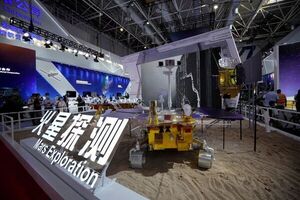
China's Mars rover likely idled by sunlight-blocking dust - designer
"China's fully robotic rover on Mars, in longer-than-expected hibernation since May 2022, likely met with excessive accumulation of sand and dust, its mission designer said, breaking months of silence about the status of the vehicle. The motorised rover Zhurong, named after a mythical Chinese god of fire, was expected to have woken up in December after entering a planned sleep mode in May 2022 as falling solar radiation with the advent of winter cut its power generation. "We have not had any communication from the rover since it entered hibernation," said Zhang Rongqiao, chief designer of China's Mars exploration programme. "We are monitoring it every day and believe it has not woken up because the sunlight has not yet reached the minimum level for power generation." An unforeseen pile-up of dust most likely affected power generation and Zhurong's ability to wake up, Chinese state television reported on Tuesday, quoting Zhang. A camera on board a NASA probe orbiting Mars showed the Chinese rover had not moved since at least September, according to official images." [...]

Lockheed Martin CubeSats Successfully Validate Essential Maneuvers For On-Orbit Servicing
"Lockheed Martin (NYSE: LMT) today announced that its In-space Upgrade Satellite System (LM LINUSS™) accomplished a successful on-orbit demonstration, proving how small satellites can serve an essential role in sustaining critical space architectures. They do this by regularly upgrading existing constellations with new capabilities and extending spacecraft design lifecycles. LM LINUSS, a technology demonstration funded internally by Lockheed Martin, is made up of two LM 50™ 12U CubeSats. While on-orbit, the system demonstrated highly-automated rendezvous and proximity operations (RPO), which enables complicated yet precise maneuvering across multi-satellite constellations. This allows on-orbit servicing coordination and upgrades at scale in any orbit. The RPO demonstration was part of Lockheed Martin's mission to validate essential maneuvering capabilities for future space upgrade and servicing missions." [...]

Japan firm fails in bid for historic moon landing
"Japanese startup Ispace conceded Wednesday its attempt to become the first company to land on the moon had ended in failure, but pledged to move ahead with new missions. The unmanned Hakuto-R Mission 1 lander had been scheduled to touch down on the moon’s surface overnight, but about 25 minutes after the landing was to have occurred, the firm could not establish contact. “It has been determined that there is a high probability that the lander eventually made a hard landing on the moon’s surface,” Ispace said in a statement. The company said its engineers were working to establish why the landing had failed. “Although we do not expect to complete the lunar landing at this time, we believe that we have fully accomplished the significance of this mission, having acquired a great deal of data and experience,” CEO and founder Takeshi Hakamada said. “What is important is to feed this knowledge and learning back to Mission 2 and beyond,” he added." [...]
Ciência e Tecnologia
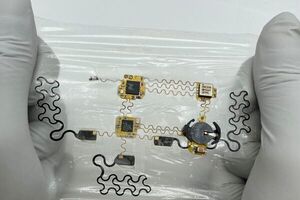
Chest E-Tattoo Boasts Major Improvements in Heart Monitoring
"A new flexible, wearable medical device could provide a major boost in the fight against heart disease, the leading cause of death in the United States. A team led by researchers at The University of Texas at Austin has developed an ultrathin, lightweight electronic tattoo, or e-tattoo, that attaches to the chest for continuous, mobile heart monitoring outside of a clinical setting. It includes two sensors that together provide a clear picture of heart health, giving clinicians a better chance to catch red flags for heart disease early. “Most heart conditions are not very obvious. The damage is being done in the background and we don’t even know it,” said Nanshu Lu, a professor in the Department of Aerospace and Engineering Mechanics and a lead author of the study. “If we can have continuous, mobile monitoring at home, then we can do early diagnosis and treatment, and if that can be done, 80% of heart disease can be prevented.” The study is published in Advanced Electronic Materials." [...]

Astronomers image a black hole’s shadow and powerful jet together for the first time
"Millimeter-VLBI image of the jet and the black hole shadow in Messier 87, obtained with the GMVA array including ALMA, the Greenland Telescope and the telescope at Metsähovi. An international team of scientists, including Aalto University researchers, has used new millimetre-wavelength observations to produce an image that shows, for the first time, both the ring-like structure that reveals the matter falling into the central black hole and the powerful relativistic jet in the prominent radio galaxy Messier 87. The image underlines for the first time the connection between the accretion flow near the central supermassive black hole and the origin of the jet. The new observations were obtained with the Global Millimetre VLBI Array (GMVA), complemented by the phased Atacama Large Millimetre/submillimetre Array (ALMA) and the Greenland Telescope (GLT). The addition of these two observatories has greatly enhanced the imaging capabilities of the GMVA. The results are published in the current issue of Nature." [...]

Research on Light Emission From Black Phosphorus Hints at New Applications
"A material known for its electronic properties could find a use in night vision, gas sensing, and spectroscopy technologies. Energy efficient LEDs (light emitting diodes) have begun to replace many types of lighting both indoor and outdoor. A key reason for the rise of LEDs has been materials research that greatly improved the quality and intensity of light achievable with these devices. But those materials must be handled with very high levels of precision, including surfaces that are as defect-free as possible. “They’re more efficient and last longer,” said Lawrence Berkeley National Laboratory (Berkeley Lab) Senior Faculty Scientist Ali Javey, of the materials that comprise today’s LED devices, “but to get good efficiencies, you really have to treat the [material] surfaces to perfection – you have to watch and control the surface chemistry and even then, you still have some light losses.” Javey is also a professor of electrical engineering and computer sciences at the University of California, Berkeley. Javey and his team said their recent research on black phosphorus (BP) – a material of interest for its electronic properties – reveals a tantalizing capability for light emission at the BP surface." [...]
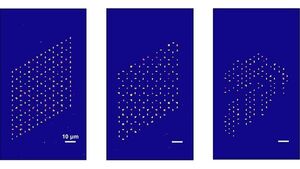
NUS quantum scientists achieve state-of-the-art defect-free atom array
"Researchers from the Centre for Quantum Technologies (CQT) at the National University of Singapore have developed a novel method to pristinely arrange rubidium atoms into arrays about as wide as a human hair with the use of optical tweezers. Using their automated setup powered by a novel algorithm, the team led by Assistant Professor Loh Huanqian, Principal Investigator at CQT, realised a defect-free 225-atom array with a success probability of 33 per cent. This is among the highest success probabilities reported in the literature for room temperature setups. Quantum arrays can help scientists to perform powerful quantum simulations of materials. Perfection in the pattern is important because defects, or missing atoms, in an array have been found to deteriorate the observed signal in quantum simulations. The CQT group achieved this by rearranging multiple atoms with several optical tweezers, making it more efficient and flawless than existing methods that only move one atom at a time using a single optical tweezer." [...]
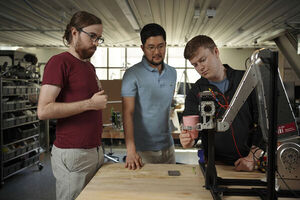
Speedy robo-gripper reflexively organizes cluttered spaces
"Rather than start from scratch after a failed attempt, the pick-and-place robot adapts in the moment to get a better hold. When manipulating an arcade claw, a player can plan all she wants. But once she presses the joystick button, it’s a game of wait-and-see. If the claw misses its target, she’ll have to start from scratch for another chance at a prize. The slow and deliberate approach of the arcade claw is similar to state-of-the-art pick-and-place robots, which use high-level planners to process visual images and plan out a series of moves to grab for an object. If a gripper misses its mark, it’s back to the starting point, where the controller must map out a new plan." [...]

USTC Realizes Ultrahigh-density 3D Dynamic Holographic Projection
"Since the invention of holography by Denis Gabor in 1956, it is widely believed that optical holography is an ideal way to achieve a naked-eye 3D display. Nonetheless, how to dynamically reconstruct a 3D holographic display of realistic and stereoscopic scenes has been a major challenge, and the generation of a real 3D hologram is especially the most prominent bottleneck problem. GONG Lei's research group from the Department of Optics and Optical Engineering, University of Science and Technology of China (USTC), together with Prof. QIU Chengwei from the National University of Singapore (NUS), and Prof. LIANG Jinyang from the National Academy of Sciences of the University of Quebec in Canada, proposed a new method of ultrahigh-density 3D holographic projection to solve those key problems. Their research results titled "Ultrahigh-density 3D Holographic Projection by Scattering-assisted Dynamic Holography" was published online in Optica on April 6th, 2023. The 3D hologram demands continuous precise depth control of reconstructed objects. In other words, the stronger the control ability of the hologram is, the higher the effective projection plane density is; thus, the more realistic the image of the reconstructed object will be observed by human eyes." [...]

How to untangle a worm ball: Mathematicians solve a knotty mystery
"California blackworms tangle themselves up by the thousands, then separate in a split second. Their trick may inspire the design of self-detangling materials and fibers. As anyone who has ever unwound a string of holiday lights or detangled a lock of snarled hair knows, undoing a knot of fibers takes a lot longer than tangling it up in the first place. This is not so for a wily species of West Coast worm. Found in marshes, ponds, and other shallow waters, California blackworms (Lumbriculus variegatus) twist and curl around each other by the thousands, forming tightly wound balls over several minutes. In the face of a predator or other perceived threat, the worms can instantly untangle, disassembling the jiggly jumble in milliseconds." [...]
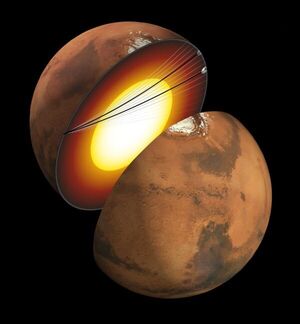
Scientists Detect Seismic Waves Traveling Through Martian Core for the First Time
"New NASA InSight research reveals that Mars has a liquid core rich in sulfur and oxygen, leading to new clues about how terrestrial planets form, evolve and potentially sustain life. Scientists observed seismic waves traveling through Mars’ core for the first time and confirmed model predictions of the core’s composition. An international research team—which included University of Maryland seismologists—used seismic data acquired by the NASA InSight lander to directly measure properties of Mars’s core, finding a completely liquid iron-alloy core with high percentages of sulfur and oxygen. Published in the Proceedings of the National Academy of Sciences on April 24, 2023, these findings reveal new insights into how Mars formed and geological differences between Earth and Mars that may ultimately play a role in sustaining planetary habitability. “In 1906, scientists first discovered the Earth’s core by observing how seismic waves from earthquakes were affected by traveling through it,” said UMD Associate Professor of Geology Vedran Lekic, second author of the paper. “More than a hundred years later, we’re applying our knowledge of seismic waves to Mars." [...]

Unlocking the power of photosynthesis for clean energy production
"A new grant will allow Rochester researchers to leverage bacteria and nanomaterials to mimic photosynthesis and produce clean-burning hydrogen fuel. As the world faces an increasing demand for clean and sustainable energy sources, scientists are turning to the power of photosynthesis for inspiration. With the goal of developing new, environmentally friendly techniques to produce clean-burning hydrogen fuel, a team of researchers at the University of Rochester is embarking on a groundbreaking project to mimic the natural process of photosynthesis using bacteria to deliver electrons to a nanocrystal semiconductor photocatalyst. By leveraging the unique properties of both microorganisms and nanomaterials, the project has the potential to replace current approaches that derive hydrogen from fossil fuels, revolutionizing the way hydrogen fuel is produced and unlocking a powerful source of renewable energy. The Rochester team, led by Kara Bren, the Richard S. Eisenberg Professor in Chemistry, along with Todd Krauss, a professor of chemistry; Anne S. Meyer, an associate professor of biology; and Andrew White, an associate professor of chemical engineering, received a nearly $2 million, three-year grant from the US Department of Energy (DOE) to create their “living bio-nano system” to produce solar hydrogen. “Hydrogen is definitely a fuel of high interest for the DOE right now,” Bren says." [...]
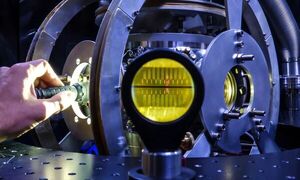
Two qudits fully entangled
"Recently quantum computers started to work with more than just the zeros and ones we know from classical computers. Now a team at the University of Innsbruck, Austria, demonstrates a way to efficiently create entanglement of such high-dimensional systems to enable more powerful calculations. In the world of computing, we typically think of information as being stored as ones and zeros – also known as binary encoding. However, in our daily life we use ten digits to represent all possible numbers. In binary the number 9 is written as 1001 for example, requiring three additional digits to represent the same thing. The quantum computers of today grew out of this binary paradigm, but in fact the physical systems that encode their quantum bits (qubit) often have the potential to also encode quantum digits (qudits), as recently demonstrated by a team led by Martin Ringbauer at the Department of Experimental Physics at the University of Innsbruck." [...]

Cheaper method for making woven displays and smart fabrics – of any size or shape
"Researchers have developed next-generation smart textiles – incorporating LEDs, sensors, energy harvesting, and storage – that can be produced inexpensively, in any shape or size, using the same machines used to make the clothing we wear every day. The international team, led by the University of Cambridge, have previously demonstrated that woven displays can be made at large sizes, but these earlier examples were made using specialised manual laboratory equipment. Other smart textiles can be manufactured in specialised microelectronic fabrication facilities, but these are highly expensive and produce large volumes of waste. However, the team found that flexible displays and smart fabrics can be made much more cheaply, and more sustainably, by weaving electronic, optoelectronic, sensing and energy fibre components on the same industrial looms used to make conventional textiles. Their results, reported in the journal Science Advances, demonstrate how smart textiles could be an alternative to larger electronics in sectors including automotive, electronics, fashion and construction. Despite recent progress in the development of smart textiles, their functionality, dimensions and shapes have been limited by current manufacturing processes." [...]

Material found in smartphone screens can be harnessed to map magnetic fields
"Hand-held magnetic field imaging equipment could be used in construction safety and medical diagnostics. Smartphones could one day become portable quantum sensors thanks to a new chip-scale approach that uses organic light-emitting diodes (OLEDs) to image magnetic fields, with significant implications for use in healthcare and industry settings. UNSW researchers from the ARC Centre of Excellence in Exciton Science have demonstrated that OLEDs, a type of semiconductor material commonly found in flat-screen televisions, smartphone screens and other digital displays, can be harnessed to map magnetic fields. The latest research, led by Dr Rugang Geng and Professor Dane McCamey from the UNSW School of Physics, has been detailed in Nature Communications. “Our findings show that OLEDs, a commercially available technology, can be used not only for displays and lighting, but also for quantum sensing and magnetic field imaging by integrating a small piece of microwave electronics,” says first author of the study, Dr Rugang Geng. “If this technology is properly developed, people could simply use their smartphones to map the magnetic fields around them, for example to spot defects in diamonds or jewellery." [...]

Light-based computing scheme reduces power needed to mine cryptocurrencies
"New photonic blockchain could make cryptocurrencies more accessible and enable low-energy optical computing Researchers have developed a new light-based computing scheme that uses a photonic integrated circuit to reduce the energy necessary for cryptocurrency and blockchain applications. Mining cryptocurrencies like Bitcoin—a process of verifying transactions and adding new cryptocurrency to the blockchain—consumes up to 1% of the world’s energy. This energy expenditure is expected to grow as cryptocurrency and blockchain applications become increasingly mainstream. Cryptocurrencies are digital currencies created using encryption algorithms. These alternative currencies require a blockchain—a type of digital ledger that records information such as transactions in a way that is difficult or impossible to change or hack. “Currently, cryptocurrency mining is only accessible to those that have access to highly discounted energy—below $0.05/kWh,” said first author Sunil Pai, who performed the research at Stanford and is now at the quantum computing company PsiQuantum." [...]

Greener batteries
"Our modern rechargeable batteries, such as lithium-ion batteries, are anything but sustainable. One alternative is organic batteries with redox-organic electrode materials (OEMs), which can be synthesized from natural "green" materials. In the journal Angewandte Chemie, a Chinese team has now introduced a new OEM for aqueous organic high-capacity batteries that can be easily and cheaply recycled. Traditional inorganic electrode materials in commercial batteries involve a whole spectrum of problems: limited resources, toxic elements, environmental problems, partly unacceptable mining conditions, limited capacity, difficulties in recycling, and high costs. No sustainable batteries can be developed on a large scale based on these electrodes, though they are needed for an energy transition. Organic batteries with OEMs are still at the very beginning of their long road toward practical application." [...]
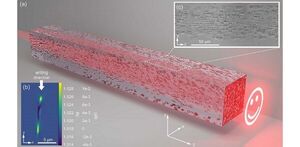
New approach to developing efficient, high-precision 3D light shapers
"Using an ultrafast laser direct writing method, researchers arrange 3D voxels in glass to precisely direct light for various applications Modern-day technologies like optical computing, integrated photonics, and digital holography require light signals to be manipulated in three dimensions. To achieve this, it is necessary to be able to shape and guide the flow of light according to its desired application. Given that light flow within a medium is governed by the refractive index, specific tailoring of the refractive index is needed to realize control of the light path within the medium. To this end, scientists have developed what are called “aperiodic photonic volume elements” (APVEs), microscopic voxels with specific refractive indices located at predefined positions to direct the flow of light in a controlled manner. However, sculpting these elements requires a high degree of precision, and most light-shaping materials are limited to 2D configurations or end up degrading the output light beam profile. In a recent study published in Advanced Photonics Nexus (APNexus), researchers led by Alexander Jesacher from the Medical University of Innsbruck in Austria proposed a simple approach to fabricating highly precise APVEs for a range of applications." [...]

Quantum entanglement could make accelerometers and dark matter sensors more accurate
"The "spooky action at a distance" that once unnerved Einstein may be on its way to being as pedestrian as the gyroscopes that currently measure acceleration in smartphones. Quantum entanglement significantly improves the precision of sensors that can be used to navigate without GPS, according to a new study in Nature Photonics. "By exploiting entanglement, we improve both measurement sensitivity and how quickly we can make the measurement," said Zheshen Zhang, associate professor of electrical and computer engineering at the University of Michigan and co-corresponding author of the study. The experiments were done at the University of Arizona, where Zhang was working at the time. Optomechanical sensors measure forces that disturb a mechanical sensing device that moves in response. That motion is then measured with light waves." [...]
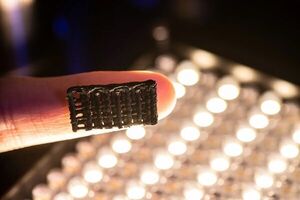
Biology major Andy Shar discovers 3D printable ink that ‘everyone was looking for,’ physics professor says
"Daeha Joung, Ph.D., supports his sophomore research mentee’s independence and success, which now includes published research. Finding a 3D printable ink that conducts electricity, yet is strong, flexible and stretchable, has been a goal of materials scientists around the world since 3D printing began, says Daeha Joung, Ph.D., an assistant professor in the Department of Physics at Virginia Commonwealth University’s College of Humanities and Sciences. So last year, when Andy Shar came into his lab eager to look for the solution, Joung was apprehensive but gave Shar a chance. And he is grateful he did. “I was trying to find that ink myself,” Joung said. “But somehow, Andy discovered the recipe.” The discovery has opened up new opportunities for Shar, now a sophomore majoring in biology in the College of Humanities and Sciences and minoring in religious studies in the School of World Studies." [...]

Astronomers solve the 60-year mystery of quasars – the most powerful objects in the Universe
"Scientists have unlocked one of the biggest mysteries of quasars – the brightest, most powerful objects in the Universe – by discovering that they are ignited by galaxies colliding. - First discovered 60 years ago, quasars can shine as brightly as a trillion stars packed into a volume the size of our Solar System, but until now it has remained a mystery what could trigger such powerful activity - By observing 48 galaxies that host quasars and comparing them to over 100 non-quasar galaxies, scientists discovered that the phenomenon is ignited by galaxies colliding - When two galaxies collide, gravitational forces push huge amounts of gas towards supermassive black holes at the centre of the remnant galaxy system that results from the collision – just before the gas is consumed by the black hole, it releases extraordinary amounts of energy in the form of radiation, resulting in a quasar - The Milky Way is likely to experience its own quasar when it collides with the Andromeda galaxy in roughly five billion years’ time Scientists have unlocked one of the biggest mysteries of quasars – the brightest, most powerful objects in the Universe – by discovering that they are ignited by galaxies colliding. First discovered 60 years ago, quasars can shine as brightly as a trillion stars packed into a volume the size of our Solar System. In the decades since they were first observed, it has remained a mystery what could trigger such powerful activity. New work led by scientists at the Universities of Sheffield and Hertfordshire has now revealed that it is a consequence of galaxies crashing together. The collisions were discovered when researchers, using deep imaging observations from the Isaac Newton Telescope in La Palma, observed the presence of distorted structures in the outer regions of the galaxies that are home to quasars." [...]
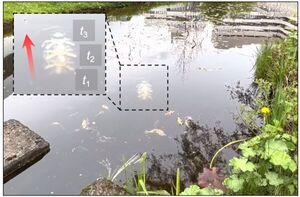
Jellyfish-like robots could one day clean up the world’s oceans
"Most of the world is covered in oceans, which are unfortunately highly polluted. One of the strategies to combat the mounds of waste found in these very sensitive ecosystems -- especially around coral reefs -- is to employ robots to master the cleanup. However, existing underwater robots are mostly bulky with rigid bodies, unable to explore and sample in complex and unstructured environments, and are noisy due to electrical motors or hydraulic pumps. For a more suitable design, scientists at the Max Planck Institute for Intelligent Systems (MPI-IS) in Stuttgart looked to nature for inspiration. They configured a jellyfish-inspired, versatile, energy-efficient and nearly noise-free robot the size of a hand. Jellyfish-Bot is a collaboration between the Physical Intelligence and Robotic Materials departments at MPI-IS." [...]
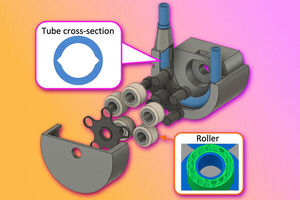
Researchers 3D print a miniature vacuum pump
"The device would be a key component of a portable mass spectrometer that could help monitor pollutants, perform medical diagnoses in remote areas, or test Martian soil. Mass spectrometers are extremely precise chemical analyzers that have many applications, from evaluating the safety of drinking water to detecting toxins in a patient’s blood. But building an inexpensive, portable mass spectrometer that could be deployed in remote locations remains a challenge, partly due to the difficulty of miniaturizing the vacuum pump it needs to operate at a low cost. MIT researchers utilized additive manufacturing to take a major step toward solving this problem. They 3D printed a miniature version of a type of vacuum pump, known as a peristaltic pump, that is about the size of a human fist. Their pump can create and maintain a vacuum that has an order of magnitude lower pressure than a so-called dry, rough pump, which doesn’t require liquid to create a vacuum and can operate at atmospheric pressure." [...]

Scientists Have Full State of a Quantum Liquid Down Cold
"New Research, Using Ultracold Atoms, Reveals Particular Properties of Quantum Systems A team of physicists has illuminated certain properties of quantum systems by observing how their fluctuations spread over time. The research offers an intricate understanding of a complex phenomenon that is foundational to quantum computing—a method that can perform certain calculations significantly more efficiently than conventional computing. “In an era of quantum computing it’s vital to generate a precise characterization of the systems we are building,” explains Dries Sels, an assistant professor in New York University’s Department of Physics and an author of the paper, which appears in the journal Nature Physics. “This work reconstructs the full state of a quantum liquid, consistent with the predictions of a quantum field theory—similar to those that describe the fundamental particles in our universe.” Sels adds that the breakthrough offers promise for technological advancement. “Quantum computing relies on the ability to generate entanglement between different subsystems, and that’s exactly what we can probe with our method,” he notes. “The ability to do such precise characterization could also lead to better quantum sensors—another application area of quantum technologies.” The research team, which included scientists from TU Wien (Vienna), ETH Zurich, Free University of Berlin, and the Max-Planck Institute of Quantum Optics, calculated quantum information measures of a quantum system via a tomography procedure—the reconstruction of a specific quantum state with the aim of seeking experimental evidence of a theory." [...]
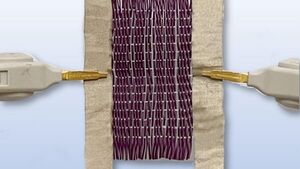
New programmable smart fabric responds to temperature and electricity
"A new smart material developed by researchers at the University of Waterloo is activated by both heat and electricity, making it the first ever to respond to two different stimuli. The unique design paves the way for a wide variety of potential applications, including clothing that warms up while you walk from the car to the office in winter and vehicle bumpers that return to their original shape after a collision. Inexpensively made with polymer nano-composite fibres from recycled plastic, the programmable fabric can change its colour and shape when stimuli are applied. "As a wearable material alone, it has almost infinite potential in AI, robotics and virtual reality games and experiences," said Dr. Milad Kamkar, a chemical engineering professor at Waterloo. "Imagine feeling warmth or a physical trigger eliciting a more in-depth adventure in the virtual world." The novel fabric design is a product of the happy union of soft and hard materials, featuring a combination of highly engineered polymer composites and stainless steel in a woven structure." [...]

Scientists discover rare element in exoplanet’s atmosphere
"The rare metal terbium has been found in an exoplanet’s atmosphere for the first time. The researchers at Lund University in Sweden have also developed a new method for analyzing exoplanets, making it possible to study them in more detail. KELT-9 b is the galaxy’s hottest exoplanet, orbiting its distant star about 670 light years from Earth. The celestial body, with an average temperature of a staggering 4,000 degrees Celsius, has since its discovery in 2016 excited the world's astronomers. The new study in Astronomy & Astrophysics reveals discoveries about the scalding-hot oddball's atmosphere. “We have developed a new method that makes it possible to obtain more detailed information." [...]
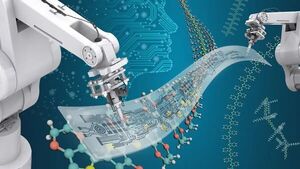
Argonne’s self-driving lab accelerates the discovery process for materials with multiple applications
"Autonomous discovery lab leading the way in transforming scientific research on sustainable and bio-inspired microelectronics. Researchers have a new scientific tool called Polybot, combining the power of artificial intelligence with robotics. Potential applications include speeding up the discovery of wearable biomedical devices, materials for better batteries and more. Today’s wearable technologies like smart glasses and watches are just the start. The next generation of flexible electronics will be more efficient and sustainable, better able to monitor our health and treat certain diseases, and much more. They will be composed of electronic polymer materials — a soft pliable substance that can conduct electricity." [...]
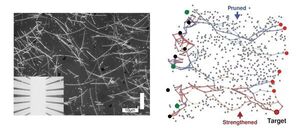
Nanowire networks learn and remember like a human brain
"An international team led by scientists at the University of Sydney has demonstrated nanowire networks can exhibit both short- and long-term memory like the human brain. The research has been published today in the journal Science Advances, led by Dr Alon Loeffler, who received his PhD in the School of Physics, with collaborators in Japan. "In this research we found higher-order cognitive function, which we normally associate with the human brain, can be emulated in non-biological hardware," Dr Loeffler said. "This work builds on our previous research in which we showed how nanotechnology could be used to build a brain-inspired electrical device with neural network-like circuitry and synapse-like signalling. "Our current work paves the way towards replicating brain-like learning and memory in non-biological hardware systems and suggests that the underlying nature of brain-like intelligence may be physical." Nanowire networks are a type of nanotechnology typically made from tiny, highly conductive silver wires that are invisible to the naked eye, covered in a plastic material, which are scattered across each other like a mesh." [...]

Researchers Design Battery Prototype With Fiber-Shaped Cathode
"In a new study, North Carolina State University researchers made a cathode, or the positive end of a battery, in the shape of a thread-like fiber. The researchers were then able to use the fiber to create a zinc-ion battery prototype that could power a wrist watch. Published in the journal ACS Applied Materials and Interfaces, the proof-of-concept study is a step forward in the development of a fiber-shaped battery that could ultimately be integrated into garments. "Ultimately, we want to make a yarn-shaped battery, so we could put it in a real garment, and preferably hide it," said the study's corresponding author Wei Gao, associate professor of textile engineering, chemistry and science at NC State. "In this study, we created a yarn-shaped cathode. Our findings were pretty promising for such a short strip of fiber, and we hope to continue this work to improve the performance, safety, and mechanical properties of our designs."" [...]

Making Quantum Processors Even Faster
"BIU researchers with colleagues from Abu Dhabi have developed a technology that improves computational performance of quantum computers A project led by a group of researchers from Israel's Bar-Ilan University, in collaboration with TII - the Quantum Research Center in Abu Dhabi, United Arab Emirates, is advancing quantum computing by improving the performance of superconducting qubits, the basic computation units of a superconducting quantum processor. The improved qubit, called a Tunable Superconducting Flux Qubit, is a micron-sized superconducting loop where electrical current can flow clockwise or counterclockwise, or in a quantum superposition in both directions. These quantum features would allow the computer to be much faster and more powerful than a normal computer. For the speed potential to be realized, the quantum computer needs to operate several hundred of qubits simultaneously without having them unintentionally interfering with each other. As an alternative technology to that existing today in quantum processors, superconducting flux qubits provide several important advantages: First, they are very fast and reliable; and second, it may be simpler to integrate many flux qubits into a processor compared to current available technology. Comparing a quantum computer to a piano, Dr. Michael Stern, of the Department of Physics and Quantum Entanglement Science and Technology (QUEST) Center at Bar-Ilan University, says, "Imagine wanting to play a certain note on a piano, but actually playing a number of keys together simultaneously and inadvertently, since the distance between the various keys isn't large enough." [...]
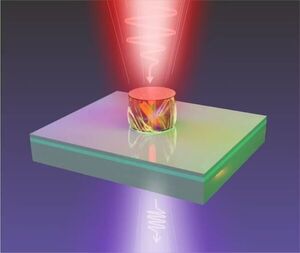
New nanoparticle source generates high-frequency light
"High-frequency light is useful. The higher the frequency of light, the shorter its wavelength—and the shorter the wavelength, the smaller the objects and details the light can be used to see. So violet light can show you smaller details than red light, for example, because it has a shorter wavelength. But to see really, really small things—down to the scale of billionths of a meter, thousands of times less than the width of a human hair—to see those things, you need extreme ultraviolet light (and a good microscope). Extreme ultraviolet light, with wavelengths between 10 and 120 nanometers, has many applications in medical imaging, studying biological objects, and deciphering the fine details of computer chips during their manufacture. However, producing small and affordable sources of this light has been very challenging." [...]

Sustainability in Space: Giving Old Satellites New Jobs
"Researchers have completed Phase One of a U.S. Space Force project looking at the feasibility of updating software on orbiting satellites. We’ve all heard that we should “Reduce, Reuse, Recycle” to save the planet, but what about applying any of the “three R’s” to space? Researchers at USC Viterbi’s Information Sciences Institute (ISI) are tackling this challenge – looking at how to reuse physical items that are already in space, namely, old satellites. Legacy Satellites There are currently several thousand satellites orbiting Earth. Many have already completed their missions or have outlived their primary lifespans – these are “legacy satellites.” And while some of them may have broken hardware and will eventually run out of energy, leave orbit, and burn out in space, others are physically in good condition. So, the question becomes: what to do with them?" [...]

NASA's New 3D-Printed Superalloy Can Take the Heat
"NASA has demonstrated a breakthrough in 3D printable high-temperature materials that could lead to stronger, more durable parts for airplanes and spacecraft. A team of innovators from NASA and The Ohio State University detailed the characteristics of the new alloy, GRX-810, in a peer-reviewed paper published in the journal Nature. “This superalloy has the potential to dramatically improve the strength and toughness of components and parts used in aviation and space exploration,” said Dr. Tim Smith of NASA’s Glenn Research Center in Cleveland, lead author of the Nature paper. Smith and his Glenn colleague Christopher Kantzos invented GRX-810. Smith and his team employed time-saving computer modeling, as well as a laser 3D printing process that fused metals together, layer-by-layer, to create the new alloy. They used this process to produce the NASA logo pictured above." [...]

DIY Neurotech: Making BCI Accessible New open-source hardware thrusts brain-signal processing into a maker’s world
"Brain-computer interfaces, or BCIs, are having a bit of a moment: Big tech companies have invested in the development of these neurotechnologies—designed to connect brains to digital machinery—specifically making substantiveacquisitions of EEG-based neurotechnology startups in recent years. Even companies like BlackRock Neurotech, Neuralink, and Synchron, which are developing surgically implanted BCI systems, are starting to break into the medical-device market, having raised a combined US $423 million to develop interfaces as medical devices as of 2021. These investments might, one day, put devices either into or onto some people’s heads. However, the science they’re built on—decoding cognitive processes into usable control signals for computer systems—has been done successfully in academic labs for decades. The mathematics and programming involved are likely not beyond the grasp of many engineers, but the required hardware has so far been prohibitively expensive for the casual DIYer. With electrodes and amplifiers easily running up into the tens or hundreds of thousands of dollars, homebrew neurotech has remained, until recently, out of grasp for many." [...]
Documentação
A documentação é parte essencial do processo de aprendizagem e a Internet além de artigos interessantes de explorar também tem alguma documentação em formato PDF interessante de ler. Todos os links aqui apresentados são para conteúdo disponibilizado livremente pelo editor do livro.
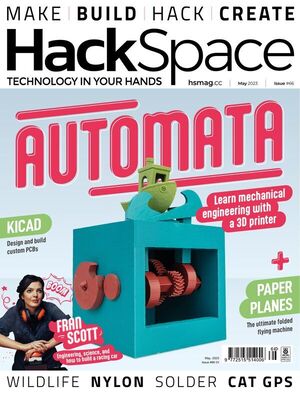
HackSpace magazine #66
"Got a 3D printer? Get learning mechanical engineering! Use cams, levers, gears and more to make unique moving machines, all designed for free and printed for the cost of a few grams of filament. It’s a lot cheaper than an engineering degree, and arguably a lot more fun too. - Craft the ultimate paper aeroplane - Power an electric scooter with a Pico - Marvel at a home-made cat-tracking device - Print in hard-wearing nylon - … and loads more! " [...]

The MagPI 129
"Topics: - DIY Home Automation with Raspberry Pi: Install home assistants, smart sensors, and more for a fully automated home. - Build your own GPT chatbot: Have a chat with your Raspberry Pi using large language models. - Get fit with Raspberry Pi: Hack your own superior smart fitness device and stay active with Raspberry Pi. - Discover GPT with Raspberry Pi: Build your own GPT chatbot and discover ClippyGPT, the classic Microsoft paperclip brought back with AI. - Camera Module guide part 1. The first in a new series of Camera Module tutorials." [...]
Projetos Maker
Diversos Projetos interessantes.

LED calculator
"A calculator with 7 LEDs and a single button. This implements a little calculator with 7 LEDs as output (applying a shift-register), a M5Stack-Atom-Lite as the MCU and its button as input. Usage Select the first number by cycling through digits 0 to 9, minus-sign "-" and decimal point "." by short press. To enter another digit double-press. To finish the number and get to the operator selection apply a long press." [...]

Ultrasonic Garage Parking Sensor LED Stop Light
"I recently added a wood rack to my garage, which unfortunately reduced the car parking depth. I now have to pull up to a few inches of the rack to allow adequate space behind the car to access the rest of my garage. Clearly, it would be nice to have something that helps reliably park very close to the wood rack without actually running into it. I know it would be easiest to attach a tennis ball to a string and hang it from my garage ceiling in front of my windshield. Clearly, not a 21st century solution! Why do something simple when you can use an ultrasonic sensor, a micro controller, LEDs, and a 3D printed housing?" [...]
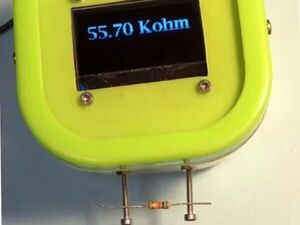
Auto-Ranging Ohmmeter
"Arduino auto-ranging ohmmeter using Pro-Mini & Oled display. Live Test: 56K ohm resistor shown. I wanted to design and build a simple ohmmeter for my electronic test bench instead of using a multimeter. I just needed to quickly measure new and used resistors to sort them for bin storage or to match certain values. The accuracy would not be that important as long as I could guess a standard value, as I quickly tested them. Then I came across Mirko Pavleski's Nano unit plus Simple Circuit project https://simple-circuit.com/arduino-auto-ranging-ohmmeter-lcd/ These were just what I was looking for." [...]

ATtiny Assembler Program
"Program an ATtiny13 development board with AVR assembly language. ATtiny13 DevBoard There are a few variations for LEDs and buttons but the ATtiny13 is just an Arduino that only has PORTB. That can be enough for many applications. We'll use a USBasp type external programmer. The vendor provides this image of the board. LED D1 is connected to pin B3 and D2 is connected to pin B4." [...]
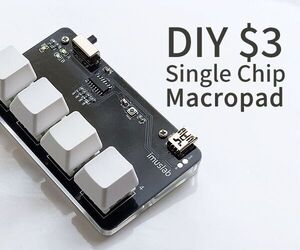
DIY $3 Single Chip Macro Keypad From Scratch (Arduino IDE Programmable!)
"Why $3 Macropad? I have always been a great fans of Maker Faires around Asia and I am thinking if I could make something special so during maker events, I can exchange gifts with the makers I like so as to start a conversation with them. As a maker primarily working in the software and electronics fields, I really like the idea of PCB business card. However, most of the PCB business card ideas have already been done. From business card that play musics, light or mini game to the magical "My business card run linux" project. I want to come up with a new idea where no one have done before, yet cheap enough so I can afford to build a few of them and giving them out for free." [...]
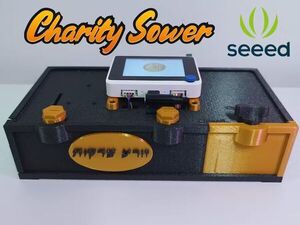
Charity Sower
"Charity Sower is an unique platform that not only enables you to donate coins, but also allows you to track the location of each donation. Overview Charity is a vital aspect of building a compassionate and empathetic society. It involves voluntarily giving time, resources, or assistance to those in need without expecting anything in return. Charitable acts not only help the recipients but also provide a sense of purpose and fulfilment to the givers. Charity can help alleviate poverty, provide healthcare, education, and other basic necessities of life. It can also promote social cohesion and bring people together to work towards a common goal." [...]
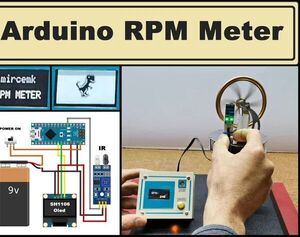
Arduino Tachometer (RPM Meter) With IR Sensor Module
"A very simple way to make a tachometer where the result is displayed on an OLED display in the form of an RPM number and a progress bar for greater visibility. Supplies - Arduino Nano R3 - SH1106 od SSD1306 Oled display 128x64 - Cheap Infrared sensor module A tachometer is an instrument measuring the rotation speed of a shaft or disk, as in a motor or other machine. The device usually displays the revolutions per minute (RPM) on Analogue dial, or on digital display. In this project, tachometer is made using an IR Sensor module as unit for measuring the number of rotations. Simply we have interfaced the IR sensor module with Arduino nano and the SH1106 Oled display. The sensor module consists of IR Transmitter & Receiver in a single pair that can work as a Digital Tachometer for speed measurement of any rotating object." [...]
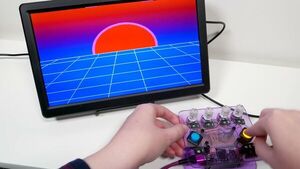
Feather RP2040 DVI Video Synth
"In this project, you'll use a Feather RP2040 with DVI Output to build a fun and funky video synth. The Feather runs Arduino code written with the Adafruit Fork of the PicoDVI library. All you'll need is USB power and an HDMI monitor to start visually vibing with shapes, colors and static. The Feather RP2040 DVI and a FeatherWing Proto are both plugged into a FeatherWing Doubler. Right Button (Next Animation Button) - Button input to FeatherWing Proto D5 - Button GND to FeatherWing Proto GND - Button LED to FeatherWing Proto D6 - Button LED GND to FeatherWing Proto GND Left Button (Shebang Button) - Button input to FeatherWing Proto D9 - Button GND to FeatherWing Proto GND - Button LED to FeatherWing Proto D10 - Button LED GND to FeatherWing Proto GND Potentiometer 0 - Pot left leg to FeatherWing Proto GND - Pot wiper to FeatherWing Proto A0 - Pot right leg to FeatherWing Proto 3.3V Potentiometer 1 - Pot left leg to FeatherWing Proto GND - Pot wiper to FeatherWing Proto A1 - Pot right leg to FeatherWing Proto 3.3V Potentiometer 2 - Pot left leg to FeatherWing Proto GND - Pot wiper to FeatherWing Proto A2 - Pot right leg to FeatherWing Proto 3.3V Potentiometer 3 - Pot left leg to FeatherWing Proto GND - Pot wiper to FeatherWing Proto A3 - Pot right leg to FeatherWing Proto 3.3V" [...]
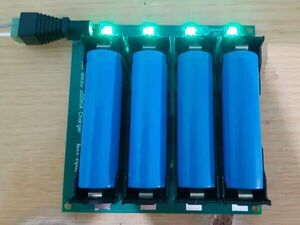
Low BOM Cost 4-cell 18650 Charger
"18650 LiPo cells are almost everywhere these days. Keeping them properly charged and maintained can be quite a pain. My attempt to fix this. Due to their high capacity and relatively low cost, LiPo cells are almost everywhere these days. This Low BOM cost 4-cell 18650 Charger module is my attempt to solve another issue. The 18650 Lipo cell is quite common in my lab, and for an excellent reason, as mentioned above, they are cost-effective and also store quite a bit of energy." [...]

How to Make DIY LED DOT MATRIX MODULE from Scratch
"LED Dot Matrix modules are an excellent way to display information in a compact and visually appealing way. These modules consist of a matrix of LEDs arranged in a grid pattern, which can be used to display graphics, text, and animations. They are widely used in digital signage, scoreboards, and other applications that require dynamic visual displays. In this tutorial, we will show you how to build a DIY LED Dot Matrix module using the MAX7219 IC. We will cover the basic principles of how these modules work, the components you will need, and the steps involved in building and programming your LED Dot Matrix module. PCB Designing - Before we can get started, first of all, We have to design the circuit, after creating the circuit, and then we have to design the PCB." [...]
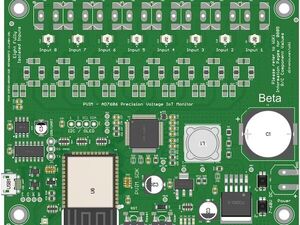
PVIM ESP32 AD7606 Precision Voltage IoT Monitor SDK Board
"This PVIM Board is a Precision, Eight Channel, Synchronous Data Acquisition board (DVM), with Simultaneously Sampled Isolated Inputs. Project Preamble During various Solar energy and Battery Storage System involvements over the years, together with integration of Home Automation for various monitoring and controlling of 'IoT stuff', a new dedicated single board was required in order to more accurately measure multiple DC voltages. Separate to this, and more importantly, is the ability to safely have full isolation between channels, so multiple battery banks, and strings, for example could be safely monitored using a single board. Thus, my shopping list of features evolved for this next project. - Accurately Measure Voltages, from a Positive and Negative Range - Low Noise - Good Dynamic Voltage Range - Self-Contained Board for IoT Projects - Minimum of Eight Totally Separate Inputs – Each Configurable - Wide DC Input Power Voltages. Board must be able to be Powered from around 12V to 48V Directly - Ability to Monitor Lead-Acid, Lithium Batteries." [...]
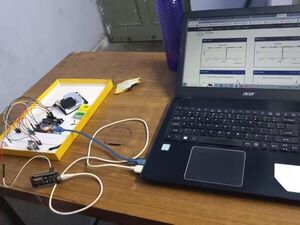
Weather Monitoring And WeatherForeCasting
"This Project Aims Weather Monitoring,predicting and Analyzing using DHT11 sensor and ThingSpeak along with Algorithms. Abstract: The Internet of Things (IoT) project on the DHT22 sensor provides a way to measure and monitor temperature and humidity in a variety of environments. This project involves using a DHT22 sensor to measure temperature and humidity, and then storing the data in a database for further analysis. The data can then be used to make decisions about climate control in a building, or to alert users when the environment is not suitable for their needs. Additionally, the data can be used to track trends in weather and climate over time, allowing for more informed decisions about how to best use resources for energy efficiency. Introduction: DHT22 sensor is a digital humidity and temperature sensor." [...]
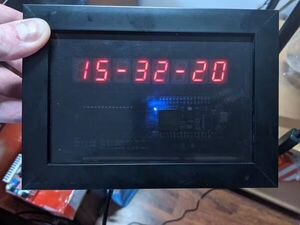
LED clock with auto time set over Wi-Fi / NTP protocol
"A seven segment LED clock that connects to the internet to automatically set the time and sync on the hour every hour. I made some internet connected 8 digit 7 segment LED displays using a NodeMCU and Harris semiconductor ICM7228A LED driver ICs the latter of which were salvaged from old aircraft avionics. As the chips would unlikely sell on eBay I decided to make them into a project and made a YouTube statistics counter. There wasn't much interest in that project but I was asked to make a clock only version so here is this project which is just a basic clock that connects to the internet and automatically sets the time. Nothing fancy; just a very accurate clock. This version uses a 8 digit 0.56″ LED display and shows the current time by default which is obtained and set automatically by querying the NTP servers available on the internet." [...]

Smooth 16x2 gauges without custom characters
"Simple design for 16x2 OLED Character Display using the US2066 chip" [...]

WS2812B RGB LED Controller over WiFi with ESP8266
"Build your own WiFi WS2812B RGB LED controller with ESP8266. The controller can be used for LED strips and arrays. Addressable RGB LEDs are devices widely used in LED arrays and strips. Among the main applications, we highlight its use in decoration of environments. Can you imagine putting a tape or a spot with LEDs to light up a specific region of a room in your house to make it more cozy? And if you can carry out this control through your cell phone via wifi?" [...]
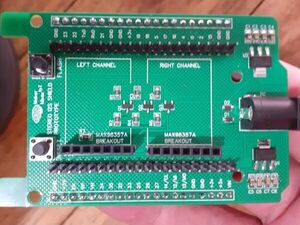
Stereo I2S Shield for ESP32-S Dev Board
"A Stereo I2S shield for use with my ESP32-S dev board, or any other I2S-capable MCU if you are so inclined... some hacking required though. Sound or music adds another level of complexity to any project. Having the ability to easily add it as a shield, allows for a reduced level of this complexity, and hopefully stimulates some inspiration along the way. This was the thought process that inspired this Stereo I2S Shield, for use with my ESP32-S Dev Board. During the design process, and actually, before, many things happened that turned this project into a slightly more complicated task than I have initially accounted for. The short and sweet is that I made a few silly mistakes on the PCB, which, for the prototype at least, has been fixed with a few jumper wires." [...]

Talkie part 1: the ESP32 Speech Synthesiser
"Speech synthesises has come a long way. If you have a Google Home or Alexa you know how well it sounds when the device talks to you. Back in the old days speech synthesises was Magic. I had a glimpse on it on an Apple II computer. I never used it myself. I had a Commodore 64 and the speech software was not widespread in the Netherlands." [...]
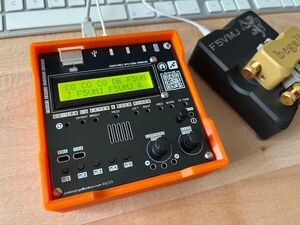
QO-100 CW Keyer and Receiver Mixer
"Zen and the pursuit of CW operation with SDR Console. After a few on-air queries, I decided to write this article which documents how I operate CW using my SDR based QO-100 groundstation. The circuit I designed incorporates the necessary functions into a single operational device. It avoids some of the CPU and SDR overhead associated with PC applications and any virtual audio cabling. Since the SDR hardware and software has no easy way of easily generating a CW signal directly, I use an injected audio tone in SSB mode. It was an emission type often referred to as A2A when I first took the RAE in 1985." [...]
Secção Videos
Videos interessantes.
That's all Folks!



